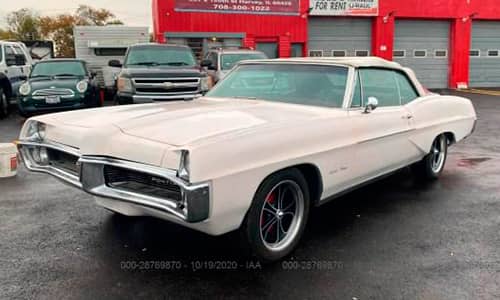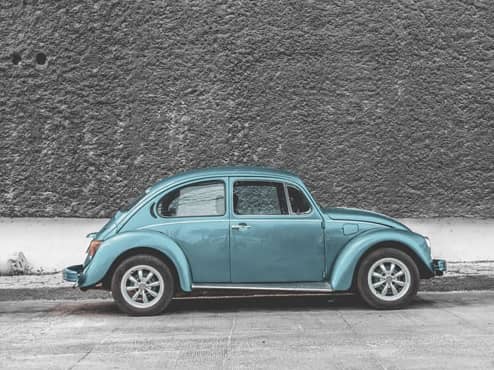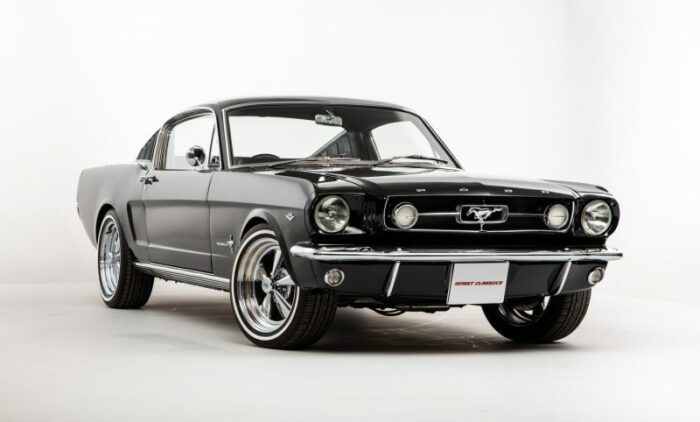Decode 13 Digit VIN - Complete Guide
Struggling to access detailed vehicle information? Using a 13-digit VIN decoder, you can easily decode VINs to uncover accurate specifications and comprehensive vehicle history.
What is a VIN?
A Vehicle Identification Number (VIN) is a unique number that identifies every vehicle manufactured. The VIN acts as an identifier, similar to a fingerprint, on every vehicle and can be used to gain access to all vehicle production details, manufacturer’s information, as well as check history records specific to that vehicle.
The standard VIN is 17 characters long but this standardization was introduced in 1981 by the National Highway Traffic Safety Administration (NHTSA). Before this 17-digit standard, VINs used in the past were of varying length with the most common being 13 digit VINs and most VIN decoders today just cannot decode these VINs. This is where Classic Decoder comes in!
Our free 13 digit VIN decoder is the ultimate solution you need to decode 13 digit VIN numbers. Classic Chevy, GM, Pontiac, GMC, Cadillac, Oldsmobile cars, name it! You can get a 13 digit VIN lookup for cars, trucks, and RVs, and view history records in a few seconds.
Where is the VIN located?
Finding the 13-digit VIN on a classic car can be a bit of a treasure hunt, as there wasn’t a standardized location before 1981. Here are some places to check:
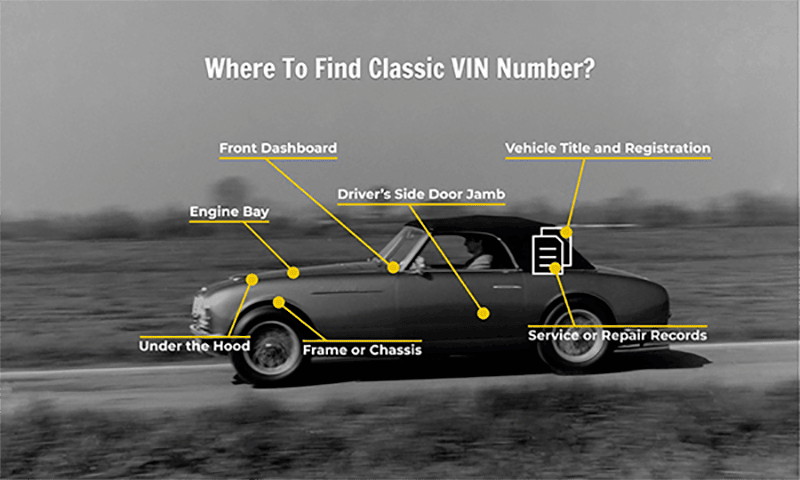
Why Should You Decode 13 Digit Classic VIN?
Classic cars are old cars that have been around for at least twenty years with some dating back to the 1950s. This means there are several details you cannot get about the car from the seller or history books.
Decoding the VIN gives you complete access to the manufacturer’s information such as year, make, model, and also gives you full access to vehicle history and records.
Some reasons why you should consider decoding the VIN of a classic vehicle include:
Verification of authenticity
The easiest way to verify the authenticity of a classic vehicle is by decoding the VIN numbers. It helps confirm whether the vehicle matches the specifications claimed by the seller, ensuring that you're making the right investment.
Detailed Historical Records
When you look up a classic VIN, you can easily tell the vehicle’s current condition and make the right choices. With access to accident records, theft records, title brand records, and more, you can spot potential complications and avoid damaged vehicles.
Verify motor vehicle safety
With access to accident records, damage records, salvage title checks, and vehicle history, you can easily check if the car had any safety-related issues in the past and identify potential damage. This information is essential for ensuring that the classic car meets current safety standards and regulations.
Easily identify car parts
If you are in the market for car parts for repairs or replacement, decoding the VIN gives you an idea of where to start. With a list of original specifications, you can easily find the right parts for any classic vehicle in the market.
Gain an advantage in the classic car market with a detailed vehicle history report.
How To Decode 13 Digit VINs?
To get a 13 digit VIN lookup, all you need to do is:
How to Read a 13 Digit VIN Number?
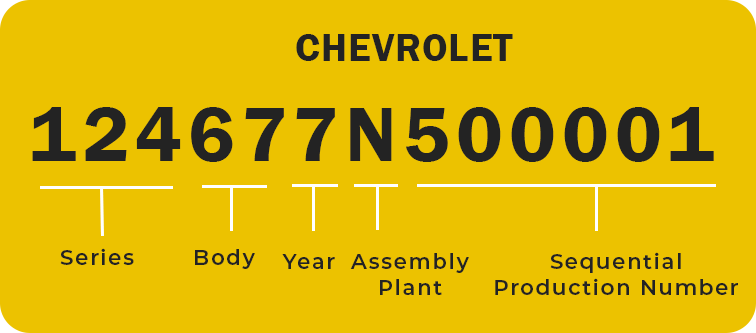
To effectively decode 13 digit VINs manually, you need to understand clearly what each character stands for and the information it carries. Here is a detailed breakdown:
1st Digit
The first digit of the 13 digit VIN represents the manufacturer of the vehicle, referred to as the series origin.
2nd Digit
The second digit in the VIN number sequence indicates the specific series model of the classic vehicle.
3rd Digit
The third character in the VIN provides the engine specifications – number of cylinders.
4th and 5th Digits
Characters four and five provide information on the vehicle’s body style.
6th Digit
The sixth digit represents the model year.
7th Digit
The seventh character of the vehicle VIN sequence gives the production plant information.
8th to 13th Digits
These characters on the car’s VIN serve as a unique “serial” number for each vehicle. While they may not provide detailed information, they distinguish one vehicle from others of the same kind produced on the assembly line.
While these general guidelines apply to many classic VINs, keep in mind that variations exist because there was no standardized format until 1981.
Most of the time, you can only get so little information without a tool. For a detailed breakdown, you will need to decode 13 digit VIN numbers with our decoder. Try it now and access comprehensive specifications and information encoded in the number.
Common Challenges with 13-Digit VINs
Having a classic car with a 13 digit VIN in itself is not a problem, however, it comes with a few challenges. Some of the issues you may experience with these VINs are:
Limited Data Sources
Generally, decoding 13-digit VINs is very difficult since most VIN decoders and vehicle history databases are currently built for the 17-digit format. This may lead to the VIN being rejected or decoded with wrong information. Classic Decoder, however, makes it look easy! We are the first in the market to offer this service without any challenges.
Lack of historical data
One common challenge for buyers and sellers with 13-digit VINs is lack of historic data. This makes it difficult to verify the vehicle’s past records. Imagine tracking history records from almost 100 years ago! There may be little or no records available on a vehicle's past ownership, maintenance, and any incidents it may have been involved in.
Potential Registration Hurdles
Some of the original papers of classic vehicles may have been destroyed or even lost over the years. This makes it difficult to register or transfer ownership for classic cars.
Insurance Complications
Some insurance companies might require additional verification or have limited access to vehicle history with a 13-digit VIN, potentially impacting insurance rates or coverage.
Finding compatible parts
With classic cars, it becomes challenging to identify the exact parts needed for repair or restoration. You may need to search for professionals or restorationists and this may cost you some good money.
These are a few challenges you may face with 13-digit VINs and Classic Decoder is here to make it easier for you! With our tools, you can query a particular vehicle’s VIN easily and generate history reports for insurance purposes. You can also access a list of original vehicle specifications to help in your search for compatible parts.
Trust Classic Decoder to do the hard work for you!
Benefits Using Classic Car VIN Decoder
Our classic decoder can find VIN number online and vehicle history report services span all antique VIN types including those as short as 5 digits. Sometimes these 5 digits may be referred to as serial numbers. When you generate a vehicle history report you can expect to get the following information:

Usually from VIN decoding but also included in the report are the year, make model, trim level, body style, dimensions, engine size, suspension, gear ratios, capacities, exhaust, ignition, wheels, rims, tires, fuel economy, and more.
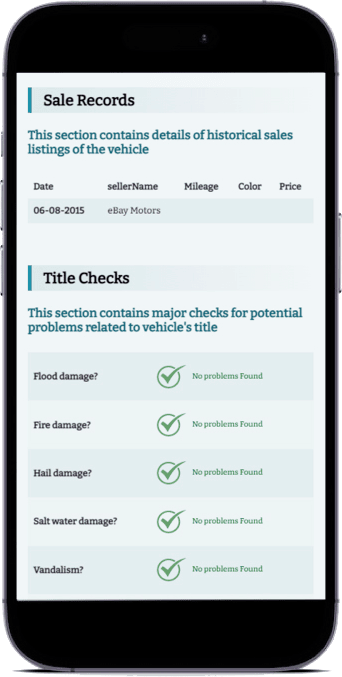
This section sheds light on where and when the vehicle was listed for sale. Was it an online auction? It provides listing data such as mileage, color, and pricing.
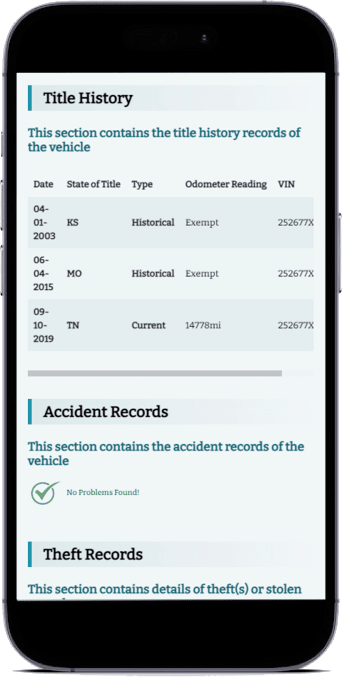
This part of the report shows how many times the car title was changed, specifying the odometer reading at each time.

This section shows records of accidents and damages done to this vehicle.
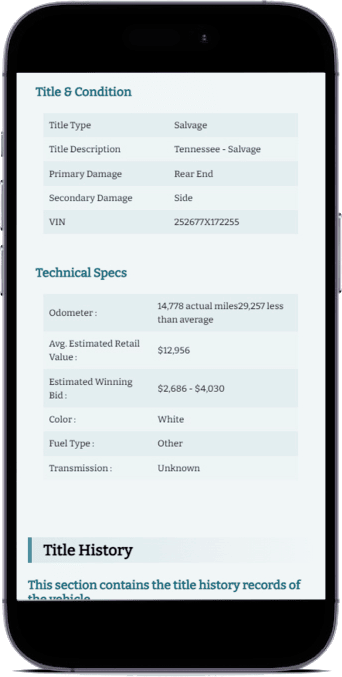
This shows comprehensive 60+ title checks, inclusive are DMV salvage title, rebuilt, junk title, insurance, and more.
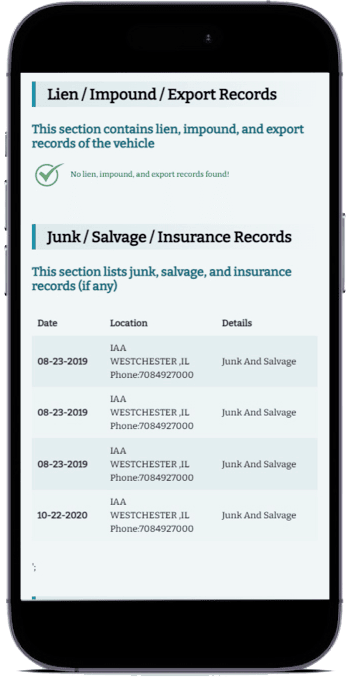
Does the vehicle have any outstanding lien and loan? this section will answer the question.

While we do not provide owners' biodata, this section does provide the number of previous owners of the vehicle, ownership duration, and usage location.
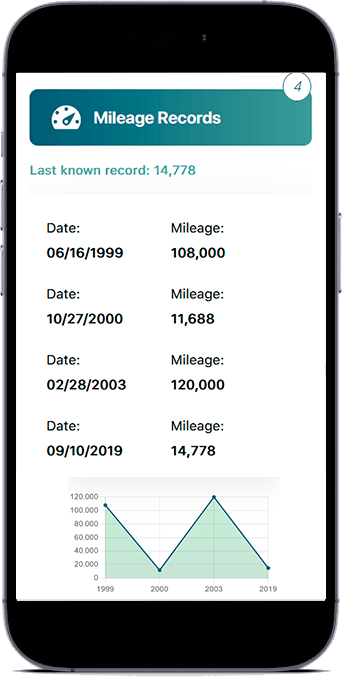
The odometer reading for the vehicle is also provided if there are issues such as a rollback.
Year, make model, trim level, body style, dimensions, engine size, suspension, gear ratios, capacities, exhaust, ignition, wheels, rims, tires, fuel economy, and more.
Lookup a VIN to view the total number of owners, locations, and duration of ownership.
Check if the vintage car was involved in an accident in the past. Avoid buying one with hidden structural damages.
Check how many times the car’s title was changed in the past, type, odometer reading, and VIN.








Get access to 60+ title checks including salvage title, rebuilt, junk title, and and more
Check for outstanding lien and loan records on the vehicle. This helps to prevent financial complications in the future.
Historical sales listings of the used car, including the Classifieds, or digital marketplace, mileage, color, and price.
Check the number of miles on the vehicle before purchase or sale, to spot mileage discrepancies.
What Does a Classic History Report Look Like?
Here is the detailed vehicle history report of a 1967 Pontiac Catalina Series 25200:
Simplify VIN Checks With Our Mobile Application
What does the Classic Car VIN decoder application provide:
- Free 13 digit VIN decoding.
- Free garage feature: Add classic cars to the garage for free.
- Accurate and Fast - returns results within seconds.
- Access vehicle reports and build sheets from your comfort zone
- Detailed build sheets for all vehicles
- User-friendly experience
- Android and iOS versions available
- 24/7 customer service
Classic Decoder vs. VINAudit vs. VINData: Which is the Better VIN Decoder?
| Comparison | Classic Decoder | VINAudit | VIN Data |
|---|---|---|---|
| Standard specifications | |||
| Vehicle images | |||
| Sales listings | |||
| Accident and damage records | |||
| Vehicle Usage Record | |||
| Event Verification | |||
| Theft records | |||
| Title brand records | |||
| Auction records | |||
| Car mileage | |||
| Ownership records | |||
| Detailed reports | |||
| Lien and loan records | |||
| Detailed Vehicle History |
Get Build Sheets With Production Data
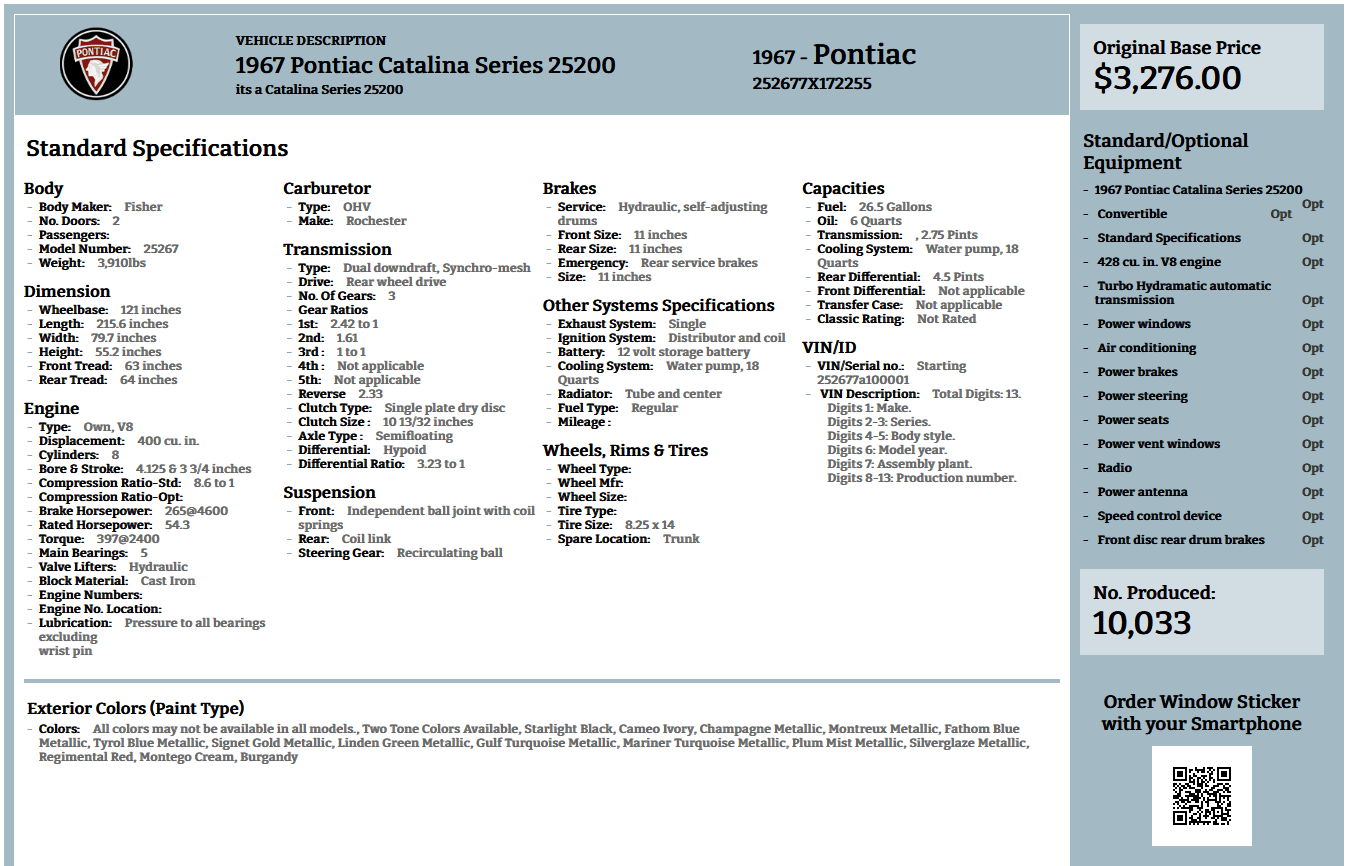
In the early days, build sheets were used as checklists during vehicle manufacture. These documents are extremely important for classic car collectors and buyers. With a build sheet, you can access accurate production data, vehicle manufacturer information, technical specifications, engine type, build plant and country, transmission, drivetrain, suspension, and more.
Unique Stories Behind Classic Cars
Did you know, behind every classic car, there is a unique story? These vintage vehicles have witnessed history, captured imaginations, and left indelible marks on automotive culture. Here are some captivating tales:

The Shelby Cobra: A Transatlantic Love Affair
- Carroll Shelby, an American racing driver, dreamed of creating a sports car that could rival European legends.
- He combined a lightweight British AC Ace chassis with a powerful Ford V8 engine, birthing the Shelby Cobra.
- The Cobra’s raw power and sleek design turned heads, but its true magic lay in its ability to conquer racetracks.
- From Le Mans to the Bonneville Salt Flats, the Cobra roared, leaving tire marks and legends in its wake.


The Volkswagen Beetle: From Hitler’s Vision to Global Darling
- Designed by Ferdinand Porsche at Adolf Hitler’s request, the Beetle (or “Käfer”) was meant to motorize Germany.
- Post-World War II, the Beetle transformed into a symbol of resilience and affordability.
- Herbie, the lovable anthropomorphic Beetle from Disney movies, further endeared it to hearts worldwide.
- Today, the Beetle remains a cultural touchstone, buzzing through memories and nostalgia.

The Ferrari 250 GTO: Racing Royalty
- Only 39 Ferrari 250 GTOs were ever built, making them rarer than unicorn tears.
- These prancing horses dominated racetracks in the 1960s, winning championships and hearts.
- Their lineage includes famous drivers like Stirling Moss and Phil Hill.
- Owning a 250 GTO is like possessing a Stradivarius violin – a symphony of speed and elegance.


The Ford Mustang: Pony Car Revolution
- Lee Iacocca, Ford’s visionary executive, wanted a car that would ignite passion.
- The Mustang galloped onto the scene in 1964, capturing the spirit of freedom and rebellion.
- From Steve McQueen’s Highland Green '68 Fastback in “Bullitt” to modern-day Shelby GT500s, the Mustang’s legacy races onward.
- It’s not just a car; it’s a stampede of dreams.
Will Classic Cars be Worthless?
Will Classic Cars Be Worthless is a common question that many people ask. As time goes on, classic cars are unlikely to lose value. Their rarity, historical significance, and emotional appeal ensure they remain in demand. Enthusiasts and collectors continue to invest in these vehicles, making them valuable today and for the future.
Frequently Asked Questions
What vehicle information is available with a free 13 digit VIN decoder?
Our free 3 digit VIN decoder reveals information such as year, make, model, engine type, transmission, fuel type and capacity, drive type, body dimensions, axle specifications, tire details, and the number of doors and gears.
Can I get a full vehicle history report for a Chevrolet with a 13-digit VIN?
Yes. Utilize our Chevy 13 digit VIN decoder to get the vehicle history report which includes available records for title history, sales records, lien/loan information, auction records, odometer readings, accident history, and theft status.
Does a 13-digit VIN decoder provide information on the car’s transmission and gears?
Yes, the decoder provides information on the type of transmission and the number of gears, which is especially valuable for those restoring or verifying classic cars.
Will the history report show any past title issues for a 13-digit VIN vehicle?
Yes, the title history includes any past issues or notable changes, helping you verify the car’s title status and ownership legitimacy.
Can I check if there are any active liens on a John deere Gator with a 13-digit VIN?
Yes. Our John Deere Gator 13 digit VIN decoder checks for lien or loan records, which are part of the vehicle history report. This allows you to confirm if there are any outstanding financial claims associated with the vehicle.
